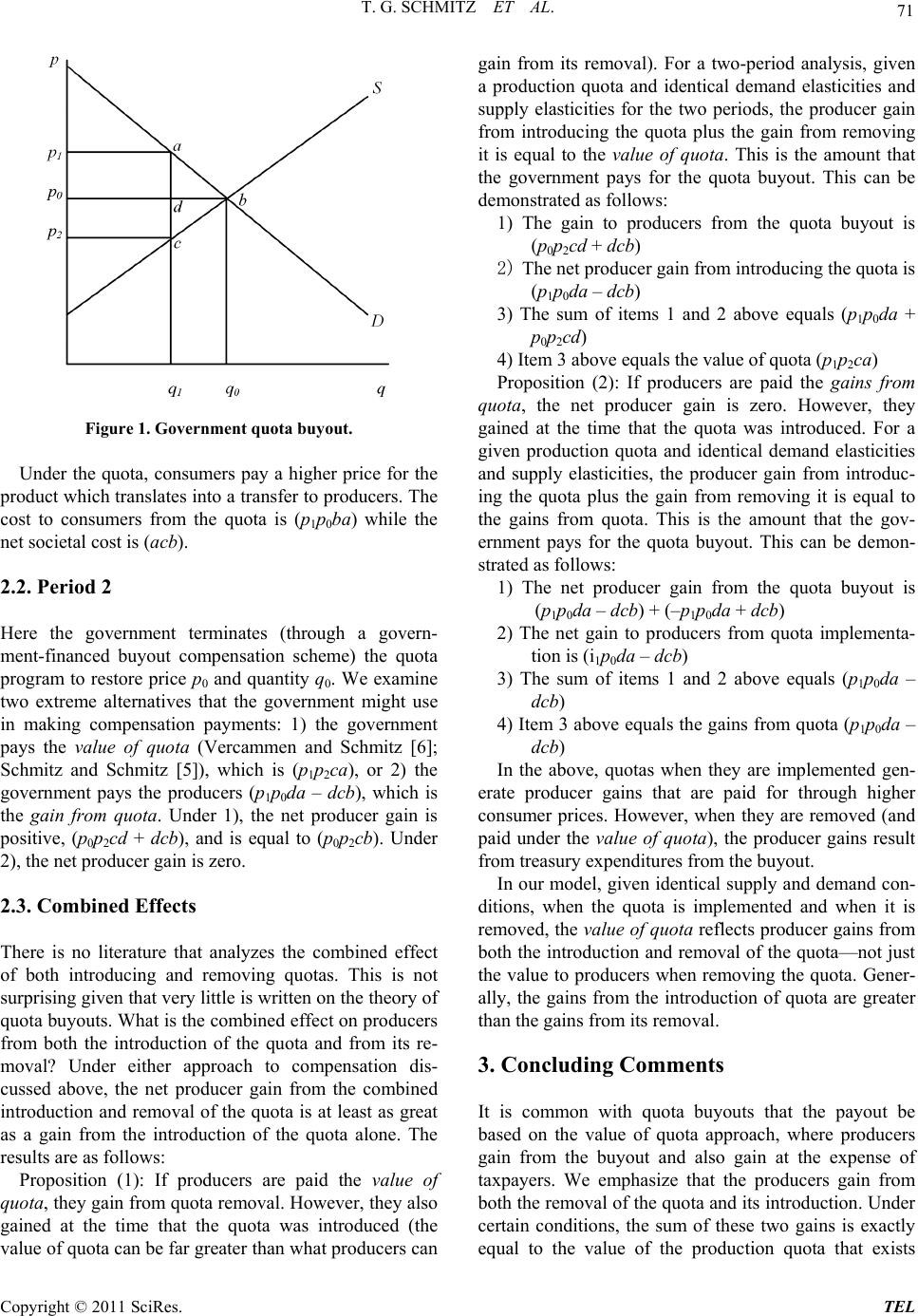
71
T. G. SCHMITZ ET AL.
Figure 1. Government quota buyout.
Under the quota, consumers pay a higher price for the
product which translates into a transfer to producers. The
cost to consumers from the quota is (p1p0ba) while the
net societal cost is (acb).
2.2. Period 2
Here the government terminates (through a govern-
ment-financed buyout compensation scheme) the quota
program to restore price p0 and quantity q0. W e examine
two extreme alternatives that the government might use
in making compensation payments: 1) the government
pays the value of quota (Vercammen and Schmitz [6];
Schmitz and Schmitz [5]), which is (p1p2ca), or 2) the
government pays the producers (p1p0da – dcb), which is
the gain from quota. Under 1), the net producer gain is
positive, (p0p2cd + dcb), and is equal to (p0p2cb). Under
2), the net producer gain is zero.
2.3. Combined Effects
There is no literature that analyzes the combined effect
of both introducing and removing quotas. This is not
surprising given that very little is written on th e theory of
quota buyouts. What is the combined effect on producers
from both the introduction of the quota and from its re-
moval? Under either approach to compensation dis-
cussed above, the net producer gain from the combined
introduction and removal of the quota is at least as great
as a gain from the introduction of the quota alone. The
results are as follows:
Proposition (1): If producers are paid the value of
quota, they gain from quota removal. However, they also
gained at the time that the quota was introduced (the
value of quota can be far greater than what produ cers can
gain from its removal). For a two-period analysis, given
a production quota and identical demand elasticities and
supply elasticities for the two periods, the producer gain
from introducing the quota plus the gain from removing
it is equal to the value of quota. This is the amount that
the government pays for the quota buyout. This can be
demonstrated as follows:
1) The gain to producers from the quota buyout is
(p0p2cd + dcb)
2) The net producer gain from introducing the quota is
(p1p0da – dcb)
3) The sum of items 1 and 2 above equals (p1p0da +
p0p2cd)
4) Item 3 above equals the value of quota (p1p2ca)
Proposition (2): If producers are paid the gains from
quota, the net producer gain is zero. However, they
gained at the time that the quota was introduced. For a
given production quota and identical demand elasticities
and supply elasticities, the producer gain from introduc-
ing the quota plus the gain from removing it is equal to
the gains from quota. This is the amount that the gov-
ernment pays for the quota buyout. This can be demon-
strated as follows:
1) The net producer gain from the quota buyout is
(p1p0da – dcb) + (–p1p0da + dcb)
2) The net gain to producers from quota implementa-
tion is (i1p0da – dcb)
3) The sum of items 1 and 2 above equals (p1p0da –
dcb)
4) Item 3 above equals the gains from quota (p1p0da –
dcb)
In the above, quotas when they are implemented gen-
erate producer gains that are paid for through higher
consumer prices. However, when they are removed (and
paid under the value of quota), the producer gains result
from treasury expenditures from the buyout.
In our model, given identical supply and demand con-
ditions, when the quota is implemented and when it is
removed, the value of quota reflects producer gains from
both the introduction and removal of the quota—not just
the value to producers when removing the quota. Gener-
ally, the gains from the introduction of quota are greater
than the gains from its removal.
3. Concluding Comments
It is common with quota buyouts that the payout be
based on the value of quota approach, where producers
gain from the buyout and also gain at the expense of
taxpayers. We emphasize that the producers gain from
both the removal of the quota and its introd uction. Under
certain conditions, the sum of these two gains is exactly
equal to the value of the production quota that exists
Copyright © 2011 SciRes. TEL